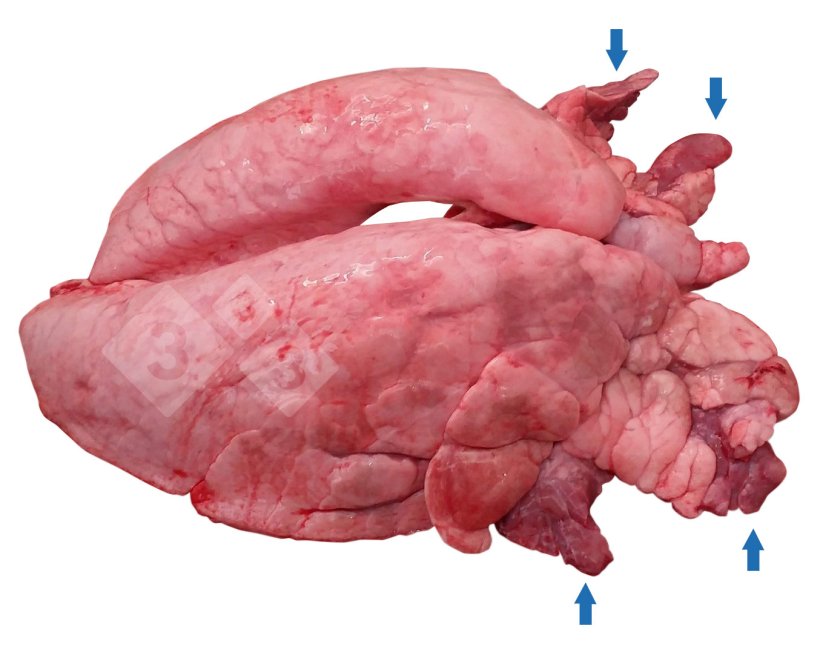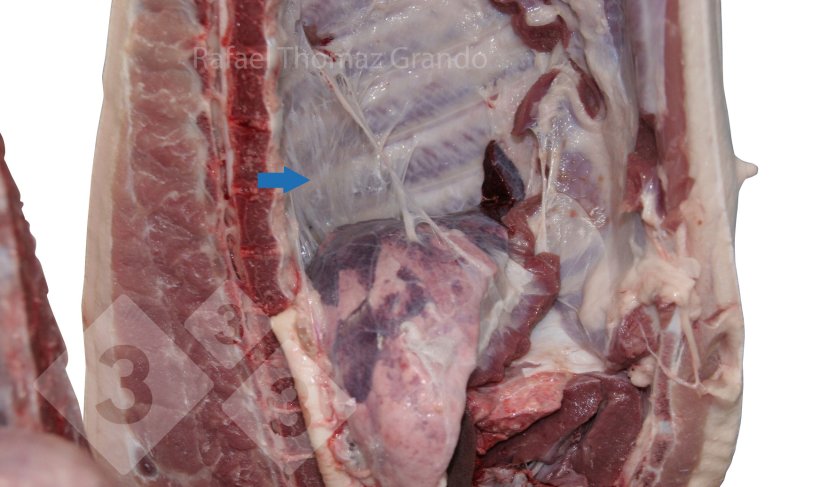Lesions in the respiratory tract of pigs are commonly detected in slaughterhouses and are considered one of the most important health and welfare problems in intensive pig farms around the world. Post-mortem evaluation of macroscopic lesions in the respiratory system of pigs is a valuable tool to identify affected herds, as well as one way to assess the severity of the lesions, both experimentally and under field conditions. This practice also makes it possible to estimate economic losses; on this account, several studies correlate production losses to observed areas of damage.
The two most common lesions evaluated in the swine respiratory tract at slaughter are cranioventral pulmonary consolidation (CVPC) (Figure 1), and pleurisy (Figure 2). CVPC is suggestive of porcine enzootic pneumonia, associated with herds infected by Mycoplasma (M.) hyopneumoniae, while pleurisies are usually consequences of several respiratory or systemic bacterial infections. These situations, when they do not cause mortality, certainly interfere with pig performance.



Recently, two review articles (Boeters et al., 2023; Maes et al., 2023) analyzed several studies on porcine respiratory diseases, pointing out, among other information, the economic consequences of lung lesions observed at slaughterhouses. Boeters et al. (2023) aimed to understand the financial consequences of endemically prevalent pathogens within the porcine respiratory disease complex (PRDC).
Results revealed that the median economic impact of one or several co-existing respiratory pathogen(s) ranged from:
- €1.70 to €8.90 per nursery pig.
- €2.30 to €15.35 per fattening pig.
- €100 to €323 per sow per year.
The authors highlighted that the porcine reproductive and respiratory syndrome virus (PRRS) was by far the most studied pathogen, followed by M. hyopneumoniae. According to Maes et al. (2023), the methodology to assess respiratory tract lesions in pigs at slaughter is an extremely useful tool for obtaining data on the health status of the herd. Further, CVPC and pleurisy have a major negative impact on pig performance, and the increase in the extension of the lesions can be due to multiple infections.
CVPC and pleurisy lesions also affect different parameters indicative of carcass and meat quality, leading to an increased risk for poor processing and storage of the carcasses.
Table 1 presents an overview of various studies that assess the impact of the presence and severity of CVPC on average daily gain (ADG) in pigs. Specifically, analyzing the economic losses related to the areas of lesions caused by M. hyopneumoniae (CPVC lesions), the study carried out by Ferraz et al. (2020) provides an objective indicator. It was observed that for every 1% increase in the CVPC lesion area, there was a 1.8 g decrease in ADG. Moreover, all experimental groups with the presence of lesions showed lower ADG when compared to individuals without lesions. Thus, the economic analysis of the study indicated that losses could reach up to US$6.55 per pig at slaughter due to infection with M. hyopneumoniae.
Table 1. Overview of some studies that assessing the impact of the presence and severity of cranioventral pulmonary consolidation (CVPC) on average daily gain (ADG) in pigs*
| Reference | Study population | Impact on ADG | Comment |
|---|---|---|---|
| Regula et al., 2000 | Seven farms (18 cohorts with 30-35 pigs/cohort) | -6.8 g/day for every 1% of affected lung | Serologic testing was more effective than slaughter evaluation in assessing the impact of subclinical infection on ADG. |
| Donko et al., 2005 | One farm (138 pigs) | Score 2: -45 g/day (-6%) Score 3: -90 g/day (-11%) |
Lung consolidation: score 1: 0-5%; score 2: 6-40%; score 3: >40% Score 2: 3.13 kg less at slaughter Score 3: 10.85 kg less at slaughter |
| Pagot et al., 2007 | 14 farms (6,997 pigs) | -7.0 g/day (0.7%) ADG for 1 point increase in severity score (1-28) | More ADG decrease in pigs with severe lesions: Score 0: 775 g; Scores 1-4: 750 g; Scores 5-8: 735 g; Score >8: 695 g |
| Ferraz et al., 2020 | One farm (500 pigs) | -1.8 g/day for each 1% of affected lung surface | Financial loss of $6.55 in pigs with more than 15% affected lung tissue compared to animals without lesions. |
| Paz-Sánchez et al., 2021 | One farm (108 pigs) | Pigs with CVPC and pleuritis, had 9% and 11% reduction on ADG, respectively. | Pigs with CVPC remained at the farm longer; those with >10% of lung parenchyma involvement were sent later; and had a lower average carcass weight, and a lower daily weight gain. |
* Adapted from Maes et al. (2023).
Their investigations have presented different results, but all indicate significant production losses:
- Regula et al. (2000) reported a decrease in ADG of 6.8 g for each percent of affected lung tissue.
- Donko et al. (2005) showed a reduction in ADG during the fattening period of 5.5% and 11% for pigs with CVPC score 2 (5-40% of lung tissue consolidated) and score 3 (> 40% of lung tissue consolidated), respectively.
- Pagot et al. (2007) reported that one supplementary point in the CVPC score (0-28) corresponded with approximately 0.7% of lost growth. Moreover, the presence of CVPC confirmed at slaughter can predict a reduction in the animals' growth rate of 7% and, if they are associated with pleurisy, it can reach 20%.
The impact of pleurisy
Regarding pleurisy, Actinobacillus pleuropneumoniae plays a fundamental role in the infection and development of the pleural lesion as a primary pathogen. Pasteurela (P.) multocida may cause similar lesions and/or be involved in these lesions, frequently with co-infeccion situations. The presence of M. hyopneumoniae in the lung can enhance P. multocida pathogenicity (Park et al., 2016), thus increasing the occurrence of pleurisy.
According to Petri et al. (2023) who inspected 1,015 carcasses from three different commercial pig farms, using the slaughterhouse pleurisy evaluation system (SPES) and selected 106 pleural and lung fragments for qPCR, the severity of the lung lesions was correlated with the presence of P. multocida and M. hyopneumoniae, thus highlighting the importance of co-infections. Regarding productive losses, Paz-Sánchez et al., (2021) analyzed one single herd in which CVPC and pleuritis lesions generated 9% and 11% reduction in ADG, respectively.
Furthermore, some authors reported a decrease in the quality of the meat, due to changes in pH, color, and water retention, loss in cooking quality, and changes in flavor in pig carcasses with respiratory tract injuries (Przyborowska-Zhalniarovich et al., 2023).
Finally, the occurrence of lung lesions in slaughtered pigs is an indicator of the existence of productive losses in the pig production system and highlights the need to develop strategies to control respiratory diseases in the herd.



